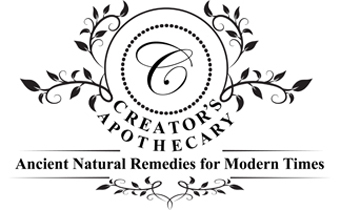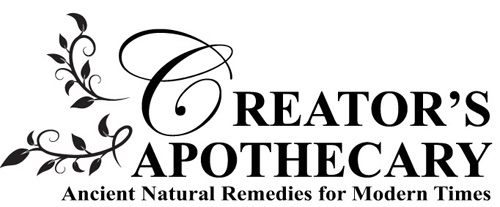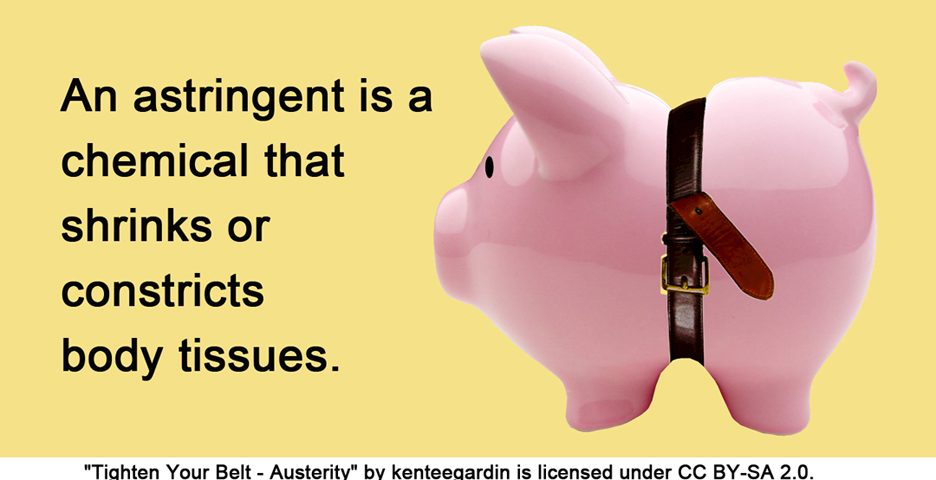Essential Oils Considered Astringent
At Creator’s Apothecary, we use only pure, natural essential oils and carrier oils in the creation of our blends and products; including serums, creams, toners and lotions that have an astringent effect. Essential Oils are derived from plants and contain naturally occurring chemical constituents.
An astringent (sometimes called adstringent) is a chemical that shrinks or constricts body tissues. The word derives from the Latin adstringere, which means “to bind fast.” Calamine lotion, witch hazel, and yerba mansa, are astringents, as are the powdered leaves of the myrtle. In medicine, astringents cause constriction or contraction of mucous membranes and exposed tissues and are often used internally to reduce discharge of blood serum and mucous secretions. This can happen with a sore throat, hemorrhages, diarrhea, and peptic ulcers.

In skincare and anti-aging, astringents may help cleanse skin, tighten pores, and dry out oil. Externally applied astringents, which cause mild coagulation of skin proteins, dry, harden, contract and protect the skin. People with acne are often advised to use astringents if they have oily skin. Mild astringents relieve such minor skin irritations as those resulting from superficial cuts; allergies; insect bites; anal hemorrhoids; and fungal infections such as athlete’s foot.
Essential Oil General Safety Information:
Essential Oils (EOs) are highly concentrated extractions of plants and can be harmful if not used carefully. Incorporating EOs into your lifestyle should not cause unnecessary work, but it is important to heed all safety precautions. Never take EOs internally, even if a label say it is safe for consumption by mouth. Never put undiluted EOs directly onto your skin (NEAT) to avoid sensitization of skin, and never apply NEAT to broken skin. Some EOs can cause irritation, sensitization or allergic reactions in some individuals. When using a new oil topically for the first time, perform a skin patch test on a small area of the skin. Some EOs are phototoxic and can cause irritation, inflammation, blistering, redness and/or burning when exposed to UVA rays of the sun. Discontinue using EOs immediately if you encounter any irritation, redness or reaction. Take care when adding EOs directly to bathwater. EOs do not stayed mixed in water, and can, therefore “pool” causing the EO to touch body areas in full strength with the potential for irritation. Some EOs should be avoided during pregnancy or by those with asthma, epilepsy, or other health conditions. Avoid using EOs near the genitals, mouth, nose, eyes and ears. Extreme caution should be used with children and elderly (due to medication mix). Care should be taken when using EOs near animals as not all EOs are safe to use on dogs, cats, birds, horses or other pets. EOs are flammable; keep them away from fire hazards. These statements have not been evaluated by the Food and Drug Administration. These oils are not intended to diagnose, treat, cure or prevent any disease.
Cedarleaf aka Thuja Thuja occidentalis – AROMATHERAPY AND/OR SKINCARE USES = none.
Atlas Cedarwood Cedrus atlantica – skincare: Acne, dandruff, dermatitis, eczema, fungal infections, greasy skin, hair loss, skin eruptions, ulcers. Bronchitis, catarrh, congestion, coughs. Genito-Urinary System: Cystitis, leucorrhea, pruritis. Fragrance component and fixative in cosmetics and household products, soaps, detergents, as well as in perfumes, especially men’s fragrances.
Balsam Fir aka Canadian Balsam Abies balsamea – Skin Care: Burns, cuts, hemorrhoids, wounds. The oil from the oleoresin is used in certain ointments and creams as an antiseptic and treatment for hemorrhoids. Used in dentistry as an ingredient in root canal sealers. Also used as a fixative or fragrance component in soaps, detergents, cosmetics and perfumes.
Bay, West Indian Pimenta racemosa – Skin Care: Scalp stimulant, hair rinse for dandruff, greasy, lifeless hair, and promoting growth. Extensively used in fragrance work, in soaps, detergents, perfumes, aftershaves and hair lotions, including bay rum.
Cinnamon Bark Cinnamomum zeylanicum – astringent mucostatic: vaginitis with leucorrhea, astringent hemostatic: passive hemorrhage, esp. from lungs or intestines, including hemoptysis, haematuria, haemafecia, metrorrhagia
Clary Sage Salvia sclarea – astringent, mucostatic: diarrhea, mucous colitis, enteritis, indigestion from excessive
Cypress Cupressus sempervirens– Strong astringent blood and fluid decongestant, especially in the pelvis, lower limbs: gastrointestinal mucus, vaginal discharge (leucorrhea). fluid decongestant, astringent diuretic: oedema, including ankle and leg oedema; urinary incontinence, enuresis. Skincare – astringent, mild antiseptic, vulnerary: broken veins and capillaries, couperose, acne, wet eczema, seborrhea, varicose veins, acne, boils, rosacea, wounds. Cypress is used in both a medical and cosmetic context as a good toning astringent and vulnerary – it is reputedly more effective than Witchhazel. Skin Care: Hemorrhoids, oily and overhydrated skin, excessive perspiration, insect repellent, pyorrhea (bleeding of the gums), varicose veins, wounds.
Frangipani Plumeria rubra – The common name, ‘frangipani’, comes from the Italian nobleman, Marquis Frangipani, who created a perfume used to scent gloves in the sixteenth century. Skin Care: Inflamed and sensitive skin, mature skin, wrinkles and general skin care. Frangipani absolute is mainly used in the high-class perfumery due to its unique aroma and long-lasting qualities. It is also used in candle and soap making along with some phyto-cosmetic applications and various beauty and anti-aging skin care products.
Frankincense Boswellia sacra, Boswellia carterii – vulnerary, anti-inflammatory, detergent, antiseptic, astringent, subhaemostatic: wounds (including deep injuries), chronic ulcers, varicose ulcers, non-suppurating sores, swollen gums; psoriasis; minor bleeding. Skin Care: Blemishes, dry and mature complexions, scars, wounds, wrinkles. The gum and oil are used as fixatives and fragrance components in soaps, cosmetics and perfumes, especially oriental, spice and men’s fragrances. Employed in some pharmaceuticals such as liniments and throat pastilles. Extensively used in the manufacture of incense. The oil is used in minute amounts in some foods (such as meat products), alcoholic and soft drinks.
Galbanum Ferula gummosa, F. galbaniflua– The oil also exerts an astringent mucostatic effect on the mucosa similar to Myrrh that will benefit damp, congestive conditions (including infectious ones) such as vaginitis with leucorrhea, blennorrhoea, mucousy stool and other discharges. Its valuable topical applications include tissue regeneration and antisepsis for wounds, sores and ulcers, and maturation for boils, abscesses and furuncles.
Geranium Pelargonium graveolens– astringent mucostatic: mucus and other discharges, incl. leucorrhea, diarrhea
Goldenrod Solidago canadensis – Skin Care: Acne, cuts, inflammations of the skin, insect bites, sores, wounds. The essential oil is used in pharmaceutical and in perfumery products, especially for scenting soaps. Mustard, orange and brown dyes can be obtained from the whole plant.
Grapefruit Citrus x paradisi – Skin care: Oily skin type – subastringent, mild antiseptic: tired, congested skin; acne. Acne, congested and oily skin, promotes hair growth, tones the skin and tissues.
Myrtle aka Green Myrtle Myrtus communis – Skin care: Oily or combination skin – skin revitalizer and regenerative, capillary stimulant: devitalized, underactive cold skin, wrinkles; chronic sores, ulcers and wounds skin detoxicant (cleanser), mild astringent: skin impurities of all types, open pores. Skin care: Acne, hemorrhoids, oily skin, open pores.
Grindelia Grindelia squarrosa – The Eclectic School of Medicine used Grindelia externally topromote skin regrowth and to heal reluctant, persistent ulcers. Skin Care: Acne, blisters, cuts, eczema, dermatitis, rashes (hives etc.), stretch marks, scars, ulcers, wounds and skin care generally.
Hops Humulus lupulus – SKIN CARE: Dermatitis, rashes, rough skin, ulcers.
Hyssop Hyssopus officinalis – Hyssop is mentioned in Exodus Chapter 12 as the oil in lamb’s blood. It was used to prevent the Plague, which may be similar to AIDS today. Other Possible Uses: asthma, bruises, cleansing and purifying, dermatitis, fever, preventing scarring, scar tissue, and wounds. Bruises, cuts, dermatitis, eczema, inflammation, wounds. Employed as a fragrance component in soaps, cosmetics and perfumes, especially eau-de-cologne and oriental bases. Used as a flavor ingredient in many food products, mainly sauces and seasonings; also in alcoholic drinks, especially liqueurs such as chartreuse.
Jasmine Jasminum grandiflorum – Skin care: Sensitive, dry and mature skin types. emollient, mild anti-inflammatory, antipruritic: skin irritation and inflammation, acute eczema or dermatitis, neurogenic pruritus, skin regenerative, vulnerary: sores, ulcers, acne, scars, stretch marks; wrinkles.
Jasmine Sambac Jasminum sambac – skin care: anti-inflammatory, astringent: skin inflammations, ulcers. Therapeutic precautions: All use of Sambac jasmine absolute is contraindicated in babies, infants and young children. Internal absorption is contraindicated during pregnancy as it may be a uterine stimulant. Pharmacological precautions: An allergic reaction is very occasionally seen with topical use of Sambac jasmine absolute, most likely from a poor-quality product.
Juniper Berry Juniperus communis – subastringent, antiseptic, vulnerary: acne, boils, wet eczema, chronic wounds. Skin care: Acne, dermatitis, eczema, hair loss, hemorrhoids, oily complexions, as a skin toner, wounds. Berries and extracts are used in diuretic and laxative preparations; also, veterinary preventatives of ticks and fleas. Employed as a fragrance component in soaps, detergents, cosmetics and perfumes, especially spicy fragrances and aftershaves. Extensively used in many food products but especially alcoholic and soft drinks: the berries are used to flavor gin.
Labdanum Cistus ladaniferus – mature skin. wrinkles. strong astringent venous restorative and pelvic decongestant: varicose veins. Like the traditional remedy Labdanum, Cistus oil is recognized today as the most effective astringent, hemostatic and vulnerary aromatic remedy of the materia aromatica. Skin care: Mature skin type. vulnerary, tissue regenerator, astringent, antiseptic: wounds, fissures, sores, ulcers, especially chronic, non-healing, painful, purulence; wrinkles, scars, phlebitis; pelvic congestion with hemorrhoids, menorrhagia, prostate congestion (BPH) Used as a fixative and fragrance component in lotions, powders, soaps, detergents, colognes and perfumes, especially oriental perfumes and aftershaves. Employed in most major food categories, particularly meat products, as well as alcoholic and soft drinks.
Lemon Citrus limon – astringent: diarrhea, intestinal hyperpermeability. Skin care: Acne, anemia, brittle nails, boils, chilblains, corns, cuts, greasy skin, herpes, insect bites, mouth ulcers, spots, varicose veins, warts. Used as a flavoring agent in pharmaceuticals. Extensively used as a fragrance component in soaps, detergents, cosmetics, toilet waters and perfumes. Extensively employed by the food industry in most types of product, including alcoholic and soft drinks..
Lemon Eucalyptus Corymbia citriodora – the bark yields the gummy exudate Kino, an antibacterial astringent used in herbal medicine for infectious diarrhea
Lemongrass Cymbopogon citratus – skincare, oily type skin, astringent, antiseptic: tired, congested skin, enlarged pores; acne, boils, skin infections detoxicant, skin toner: skin impurities and blemishes lymphatic stimulant: swollen glands, lymph stagnation, edema connective tissue and epidermal restorative, antioxidant: slack, devitalized skin, wrinkles, stretch marks, cellulite, weak elastin; bruising, sprains, strains, poor muscle tone. Skin care: Acne, athlete’s foot, excessive perspiration, insect repellent (fleas, lice, ticks), open pores, pediculosis, scabies, tissue toner. Extensively used as a fragrance component in soaps, detergents, cosmetics and perfumes. Employed as a flavor ingredient in most major food categories including alcoholic and soft drinks. Also used for the isolation of citral and for the adulteration of more costly oils such as verbena or melissa.
Lotus Nelumbo nucifera – improves the texture of the skin, treats pimples and blemishes.
Manuka Leptospermum scoparium – Skin care: Acne, abscesses, athlete’s foot skin, bed sores, blisters, boils, burns, carbuncles, cold sores, cracked skin, dandruff, dermatitis, eczema, fungal infections, insect bites and stings, lice, nail infections, oily skin, pimples, ringworm, sores, sunburn, tinea and ulcers. The essential oil is much used in phyto-cosmetic and pharmaceutical preparations mainly for its potent antimicrobial properties. Commercial development of the essential oil has led to a range of products for the topical treatment of various conditions including joint pain, eczema and psoriasis. The oil is also used in perfumes and soaps. The scented flowers of the shrub attract bees, which are used for making the popular manuka honey.
Marigold Calendula officinalis – Skin care: Burns, cuts, eczema, greasy skin, inflammations, insect bites, rashes, wounds. NB: ‘The infused oil is very valuable in Aromatherapy for its powerful skin-healing properties. Used in high-class perfumery.
Mimosa Acacia dealbata – Skin care: Oily, sensitive, general skin care. Employed largely in soaps, due to its good fixative properties. Also in high-class perfumes, especially colognes, floral and oriental types.
Myrrh Commiphora myrrha – strong astringent mucosal restorative and decongestant, mucostatic, antiseptic, mild spasmolytic: chronic and acute mucous membrane weakness with mucus congestion, overproduction and discharges, simple or infectious; esp. respiratory, gastrointestinal, genital and urinary. Myrrh + Sage: astringent, anti-inflammatory, antiseptic, analgesic for gum/periodontal disease, spongy gums, mouth and throat ulcers, sore throat, hoarseness (gargle). Skincare: Mixed and mature skin type, also for wrinkles and scars. astringent, antiseptic: gum/periodontal disease, spongy gums with loose teeth, hemorrhoids, rectal prolapse, vulnerary, astringent, skin regenerator, analgesic, antiseptic: wounds, abrasions, sores, aphthous ulcers (including mouth ulcers), abscesses, cracks, fissures, scars; especially with pain, swelling, purulence/putrefaction/gangrene. Myrrh is one of the finest astringents for weak, loose or boggy tissues, with a robust ability to create and preserve physiological form and structure through the skin and mucosa.
Onycha (Benzoin) Styrax benzoin – When used topically for skin conditions, Benzoin is an excellent tissue regenerator and astringent vulnerary. Its main indications are skin irritation and wounding of any kind, including bruises, scrapes, sore nipples, chapped or itching skin, wounds, sores, ulcers and scars; it is also used alone or in compound liniments, etc., for pruritic eczema, psoriasis, pityriasis, acne, minor burns, chilblains and gangrene. Benzoin is non-irritant and non-sensitizing to the skin. However, it is contraindicated for use on sensitive or damaged skin, as permanent skin sensitization may result. Topical dilutions should therefore not exceed 2% to be safe. Benzoin should be avoided in babies and infants. Benzoin is the sap (gum resin) that comes from cuts in the trunk of trees that belong to the Styrax family and is used on the skin for ulcers, bed sores (pressure ulcers), cracked skin, and many other conditions.
Orange, Sweet & Bitter Citrus sinensis & Citrus aurantium var. amara – Skin care: Dull and oily complexions, mouth ulcers. Sweet orange peel tincture is used to flavor pharmaceuticals. Extensively used as a fragrance component in soaps, detergents, cosmetics and perfumes, especially eau-de-colognes. Extensively used in all areas of the food and drinks industry (more so than the bitter orange oil). Used as the starting material for the isolation of natural limonene.
Parsley Petroselinum sativum – Circulation muscles and joints: Accumulation of toxins, arthritis, broken blood vessels, cellulitis, rheumatism, sciatica. Genito-urinary system: Amenorrhea, dysmenorrhea, to aid labor, cystitis, urinary infection. Used in some carminative and digestive remedies, such as ‘gripe waters’. The seed oil is used in soaps, detergents, colognes, cosmetics and perfumes, especially men’s fragrances. The herb and seed oil as well as the oleoresin are used extensively in many types of food flavorings, especially meats, pickles and sauces, as well as alcoholic and soft drinks.
Patchouli Pogostemon cablin – Skin care: Oily skin type: antiseptic, subastringent, anti-inflammatory, antiallergic: oily congested skin and scalp; dandruff, acne; allergic, seborrheic and inflammatory eczema/dermatitis; thread veins. skin regenerator, emollient: irritated, rough, dry, tired, sagging or aging skin; wrinkles, skin chaps/cracks/fissures; scars, adhesions, cellulite vulnerary: sores, wounds. Skin care: Acne, athlete’s foot, cracked and chapped skin, dandruff, dermatitis, eczema (weeping), fungal infections, hair care, impetigo, insect repellent, sores, oily hair and skin, open pores, wounds, wrinkles.
Peppermint Mentha peperita – Skin care: Acne, dermatitis, ringworm, scabies, toothache.
Rose, Cabbage and Rose, Damask Rosa centifolia & Rosa damascena– Skin care: Broken capillaries, conjunctivitis (rose water), dry skin, eczema, herpes, mature and sensitive complexions, wrinkles. Rose water is used as a household cosmetic and culinary article (especially in Persian cookery). The concrete, absolute and oil are employed extensively in soaps, cosmetics, toiletries and perfumes of all types – floral, oriental, chypres, etc. Some flavoring uses, especially fruit products and tobacco.
Rosemary Rosmarinus officinalis – Skin care: Acne, dandruff, dermatitis, eczema, greasy hair, insect repellent, promotes hair growth, regulates seborrhea, scabies, stimulates scalp, lice, varicose veins. mucostatic astringent: vaginitis with leucorrhea use Rosemary and sage. Extensively used in soaps, detergents, cosmetics, household sprays and perfumes, especially colognes. Also used as a masking agent. Extensively employed in most major food categories, especially meat products, as well as alcoholic and soft drinks. Serves as a source of natural antioxidants.
Rosewood Aniba rosaeodora – Rosewood is sometimes employed in skin care preparations for combination and sensitive type of skin – as a skin regenerator and connective tissue stimulant for chronic skin conditions such as rosacea, broken capillaries, scars, stretch marks and wrinkles, and as a vulnerary, tissue repairer, astringent and antiseptic for wounds, sores, ulcers and eczema.
Sage Salvia officinalis – mucostatic astringent: mucous colitis, vaginitis, leucorrhea, spermatorrhea. use sage with green myrtle/myrrh AROMATHERAPY/HOME USE: None. Oral toxin (due to thujone). Abortifacient; avoid in pregnancy. Avoid in epilepsy. Use with care or avoid in therapeutic work altogether – Spanish sage or clary sage are good alternatives.
Sage Lavender aka Spanish Sage Salvia lavandulafolia – Skin care: Acne, cuts, dandruff, dermatitis, eczema, excessive sweating, hair loss, gingivitis, gum infections, sores. Extensively used as a fragrance component in soaps, cosmetics, toiletries and perfumes, especially ‘industrial’ type fragrances. Extensively employed in foods (especially meat products), as well as alcoholic and soft drinks.
Sandalwood Santalum album – skin care: Dry or sensitive skin types: emollient, antipruritic: dry, dehydrated, irritated, inflamed skin; acute dermatitis with pruritus and redness; skin chaps and cracks, anti-inflammatory, antiallergic, antiseptic, mild astringent: acute eczema/dermatitis and other skin inflammations, including prickly heat, with itching; stings, insect bites, scabies, acne, boils, wounds, MRSA antitumoral, anticancer: skin cancers. Skin care: Acne, dry, cracked and chapped skin, aftershave (barber’s rash), greasy skin, moisturizer. Used to be used as a pharmaceutical disinfectant, now largely abandoned. Extensively employed as a fragrance component and fixative in soaps, detergents, cosmetics and perfumes – especially oriental, woody, aftershaves, chypres, etc. Extensively used in the production of incense. Employed as a flavor ingredient in most major food categories, including soft and alcoholic drinks
Spearmint Mentha spicata – ‘The properties of spearmint oil resemble those of peppermint but its effects are less powerful … it is better adapted to children’s maladies.’ Skin care: Acne, dermatitis, congested skin.
Thyme Thymus vulgaris – Skin care: Abscess, acne, bruises, burns, cuts, dermatitis, eczema, insect bites. The oil is used in mouthwashes, gargles, toothpastes and cough lozenges. ‘Thymol’ is isolated for pharmaceutical use in surgical dressings, disinfectants etc. Used as a fragrance component in soaps, toiletries, aftershaves, perfumes, colognes, etc. Extensively employed by the food and drink industry, especially in meat products.
Thyme ct. Thymol – mucostatic astringent: vaginitis with leucorrhea
Thyme ct. gerianol – Topically it is an antiseptic astringent, like Geranium, and is often used for acne and dry and wet forms of eczema
Tsuga or Hemlock Spruce Tsuga canadensis – Used in veterinary liniments. Extensively used for room spray perfumes, household detergents, soaps, bath preparations and toiletries, especially in the USA
Vetiver Vetiveria zizanoides – antiseptic, antiputrid, subastringent: acne, dermatitis
Virginian Cedarwood Juniperus virginiana– Skin Care: Acne, dandruff, eczema, greasy hair, insect repellent, oily skin, psoriasis. Bronchitis, catarrh, congestion, coughs, sinusitis. Genito-Urinary System: Cystitis, leukorrhea. Extensively used in room sprays and household insect repellents. Employed as a fragrance component in soaps, cosmetics and perfumes. Used as the starting material for the isolation of cedrene.
Yarrow Achillea millefolium – Skin care: Acne, burns, cuts, eczema, hair rinse (promotes hair growth), inflammations, rashes, scars, tones the skin, varicose veins, wounds. Occasionally used in pharmaceutical bath preparations for skin conditions. Limited use in perfumes and aftershaves. Employed as a flavor ingredient in vermouths and bitters.
Carrier Oils with Astringent Properties
- Amaranth Seed oil
- Annatto Seed
- Sweet Almond
- Babassu Butter/Oil
- Blackberry Seed Oil
- Black Raspberry Seed
- Boysenberry Seed
- Borage Seed
- Calendula
- Camellia Seed
- Carob Pod
- Carrot Seed Oil
- Cashew Nut
- Cherry Kernel Oil
- Coconut Butter
- Cranberry Seed Oil
- Evening Primrose
- Fenugreek Oil
- Flaxseed
- Hazelnut
- Kapok Seed
- Kiwi Fruit Seed Oil
- Mango Butter
- Mangosteen Butter
- Noni Seed
- Pistachio Nut Oil
- Pomegranate
- Poppy Seed Oil
- Prickly Pear
- Red Raspberry Seed
- Rhatany Root
- Strawberry Seed
- St. John’s Wort Oil
- Walnut Seed Oil
References
- Aromatica: A Clinical Guide to Essential Oil Therapeutics (Vol. 1 & 2) by Peter Holmes LAc, MH
- Reference Guide for Essential Oils by Connie and Alan Higley
- The Encyclopedia of Essential Oils by Julia Lawless
- Astringent, https://en.wikipedia.org/wiki/Astringent
- Text Ref: Hickman, Ed. 1002; Munz, Calif. Flora, 114; Munz, Flora So. Calif. 776; Robbins et al. 130., Anemopsis from University of California, Irvine
- Brodin, Michael (1998). The Over-The-Counter Drug Book. Simon and Schuster. p. 382. ISBN 978-0-671-01380-6. Retrieved 4 June 2014.
- Peter A. Ciullo (31 December 1996). Industrial Minerals and Their Uses: A Handbook and Formulary. William Andrew. p. 407. ISBN 978-0-8155-1808-2. Retrieved 4 June 2014.
- Acheson, Austin; Scholefield, John (2008-02-16). “Management of haemorrhoids“. BMJ. 336 (7640): 380–383. doi:10.1136/bmj.39465.674745.80. PMC 2244760. PMID 18276714.
Grace to you and peace from God our Father and the Lord Jesus Christ. Philippians 1:2
Til next time,





